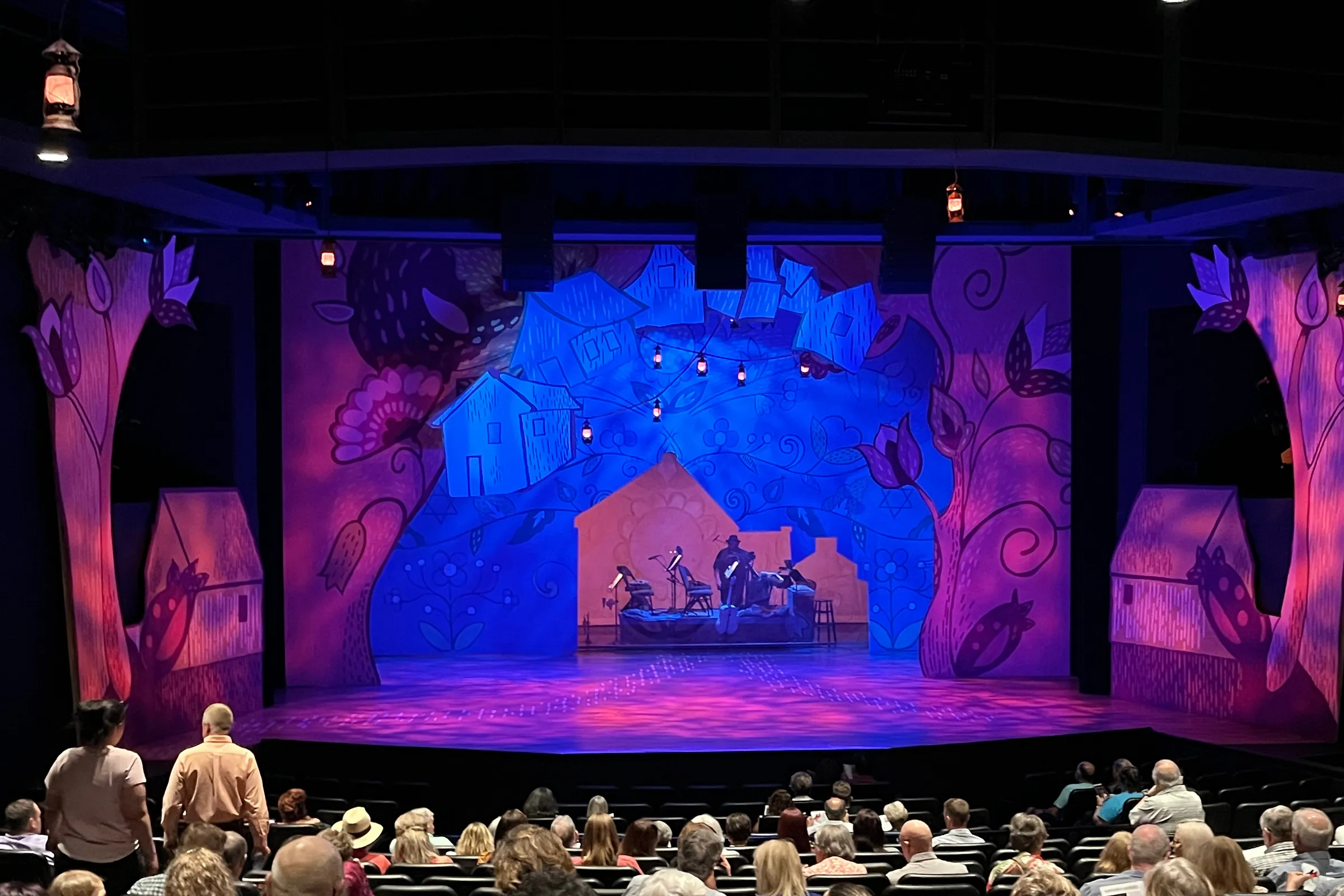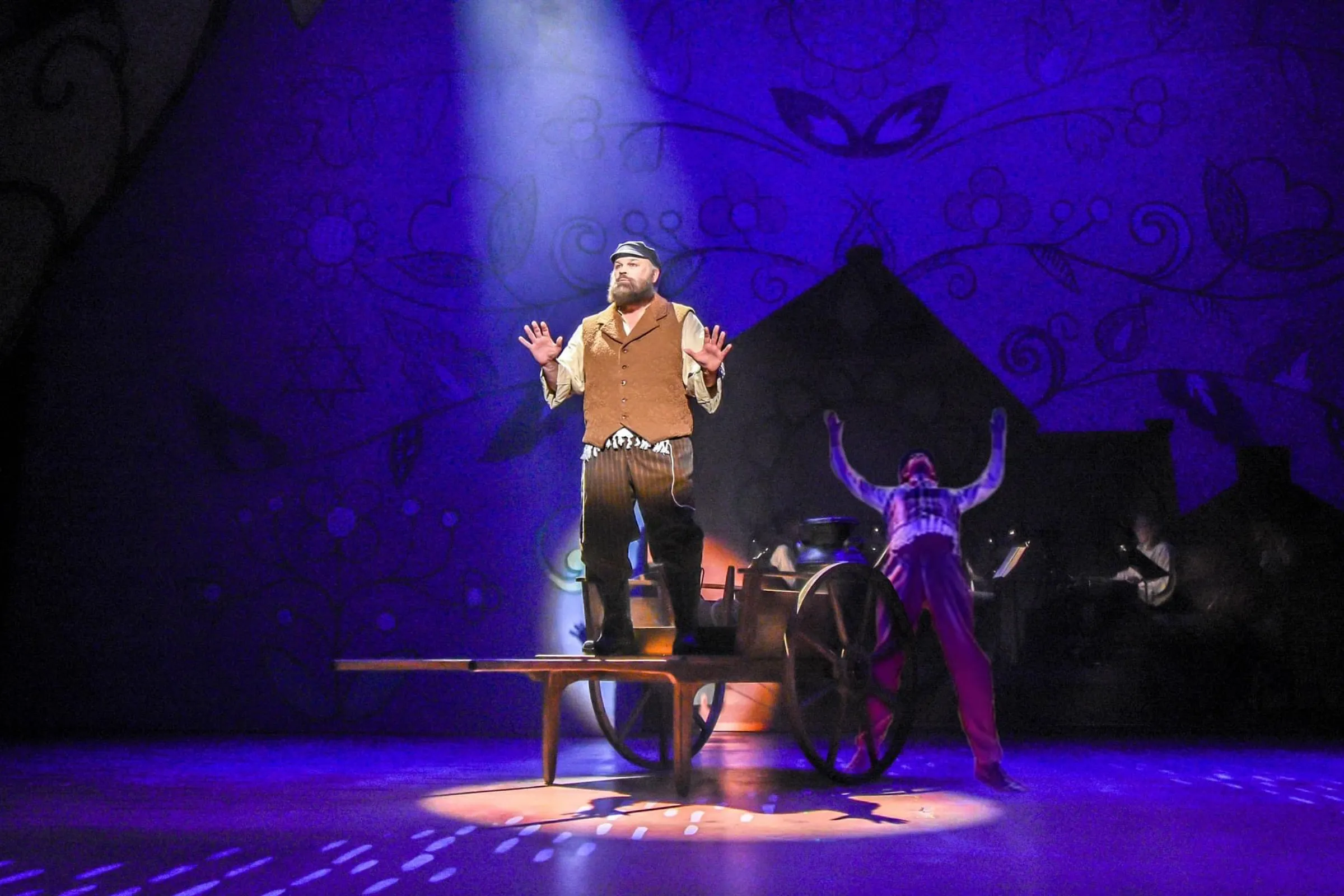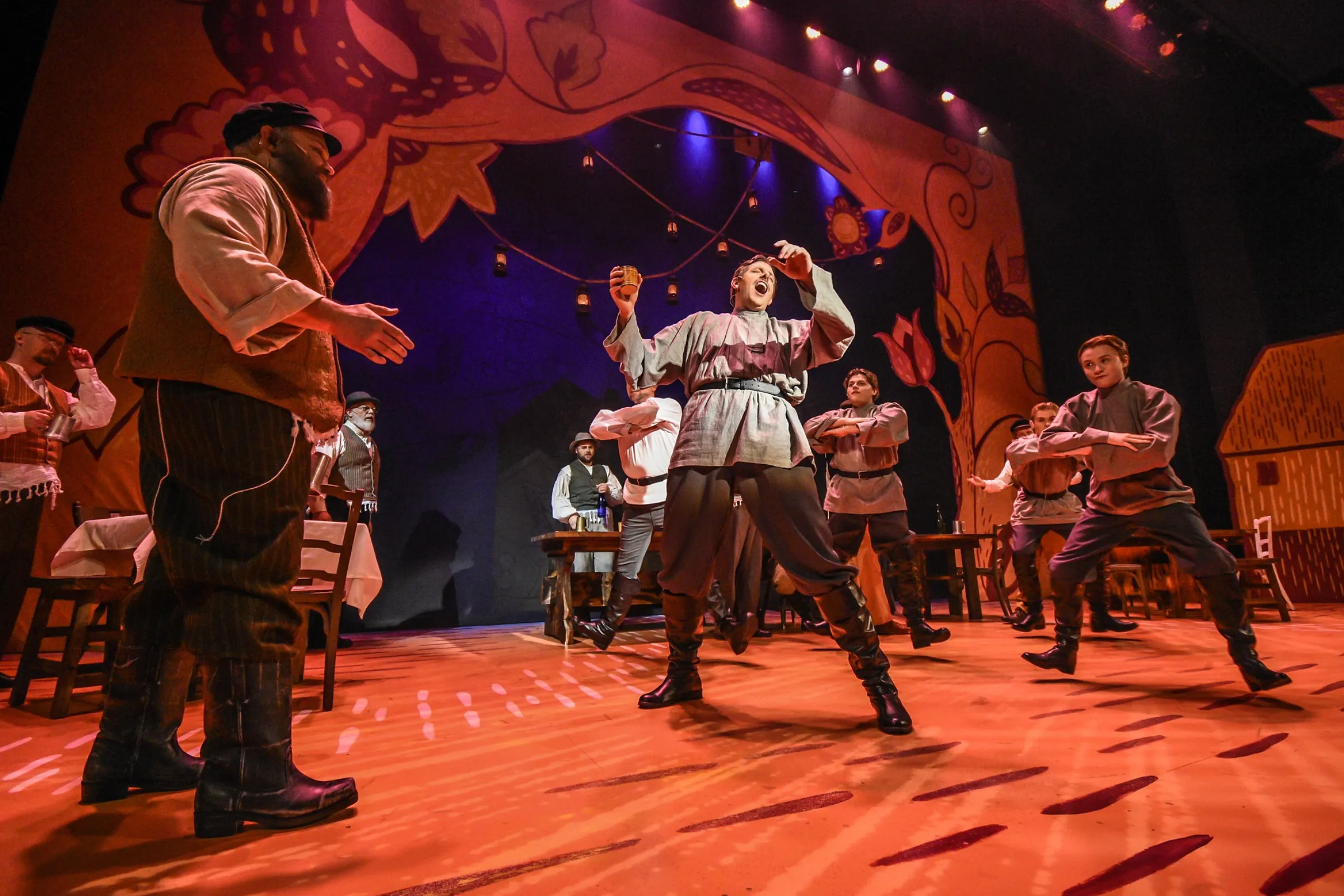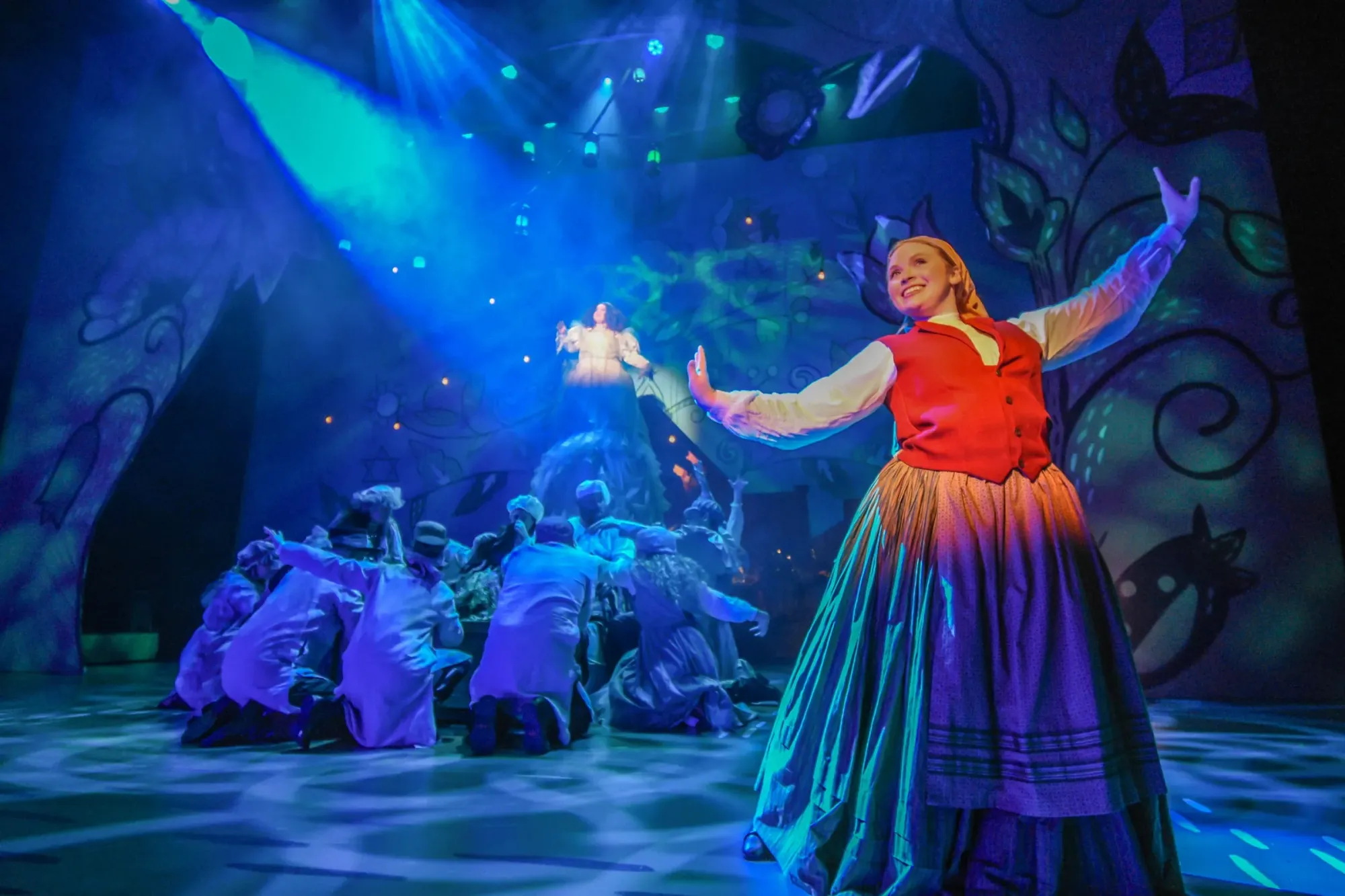TPAC Produces: Fiddler On The Roof
Tulsa Performing Arts Center
Tulsa
August 18, 2024
“I didn’t know Tulsa theatre could do that.” It’s a sentence I regularly hope to get to say to myself while watching a show. I got to say it last weekend, halfway through the Tulsa Performing Arts Center’s self-produced Fiddler on the Roof, when a line of actors with wine bottles balanced on their hats took a wedding dance number from “ok, that’s impressive” to “actually jaw-dropping” and the audience lost its collective mind.
It was the kind of spine-tingling build you live for in performing arts — that thing where you think something’s gone as far as it can go, and then it goes further. There were a handful of those moments in this show, which could have coasted on a classic musical’s beloved songs (“Sunrise, Sunset,” “Matchmaker,” “If I Were A Rich Man”), its emotional depth, and a hefty slice of local talent, but instead pushed them all towards Broadway-level excellence.
Shows that happen at the TPAC are usually produced by other organizations (Celebrity Attractions, Theatre Tulsa, Tulsa Ballet, etc.). But the TPAC is staffed by people with their own theatre chops — from the CEO (Mark Frie, here playing the lead role of Tevye, which he’s performed several times during his career) and the VP of Development (Sara Phoenix, director and choreographer) to the technical and backstage crew. Fiddler is now the second full-length musical the TPAC has produced itself; under the “TPAC Produces” label, it’s not just a home for other groups’ shows but increasingly a successful (and paying) generator of its own.
I loved seeing staff who do so much for other companies step out of service mode and into the creative spotlight — in this case, one literally designed by TPAC house electrician Carson Decker, whose alternately peachy-warm and turquoise-cool lighting gave us subtle sunrises and sunsets throughout the production. During “Sabbath Prayer,” he beamed in shafts of light from above as three families gathered with real candles below — a beautiful visual for a moment where, in this fictional shtetl of Anatevka, human devotion and divine blessing meet. (Fiddler is based on stories by the late-19th-century Yiddish/Ukrainian author Sholom Aleichem.)

Frie’s Tevye was both exhausted and ebullient — “a girl dad,” as he has described the role and himself, with shades of Tim Walz-style family devotion — excelling in this complex character’s in-between emotional spaces (“on the one hand … on the other hand … on the other hand….”). And Phoenix is up there with the best musical theatre directors in the region. She’s a consummate wrangler, able to pull a thousand threads (acting, spacing, pacing, feeling) into a fine point — whether that’s a quiet one like Tevye’s duet with his wife (“Do You Love Me?” with the superb Kim Frie as Golde), or an absolute banger like “Tevye’s Dream,” complete with Tim Burton-esque dancers and the half-zany, half-terrifying two-story-tall apparition of the deceased wife of a match Tevye needs to undo. Inspired by the original choreography by Jerome Robbins, Phoenix also created the dances for this Fiddler, full of dynamic jumps and turns, folk-dance lines and circles, and genuine showbiz moments, all performed full-throttle, especially by the young men in the cast.
A charming set by Robin Vest (read her impressive résumé here) surrounded the action with large-scale flowers and houses, hung the Williams Theater’s ceiling with lanterns, and tucked a seven-piece band into the heart of the stage. Well-worn tables and benches signaled interiors. The traditional costumes (by Alice Wegley and the late Bruce Lewis) were color-saturated and richly detailed, though the white ankle socks Tevye wore in the dream sequence looked a little more “Costco 2024” than “Russia 1905.” Accents ranged from the Jersey Shore to the Old World (with “v” for “w,” etc.), with most settling somewhere in the middle. The fiddler of the title, performed by Allison Johnston, was a minimal but potent presence (now perched in a high stage-left alcove, now leading Tevye into the dark on an empty stage): a reminder, Tevye says, that “here in our little village of Anatevka, each one of us is a fiddler on the roof, trying to scratch out a pleasant and simple tune without breaking our necks.”

The TPAC assembled a strong fleet of local actors for this show, from familiar faces to up-and-coming talents like Lillie Taylor (a junior in UCO’s musical theatre department), Gigi Jenkins (Jenks High School), Trace Hererra (Booker T. Washington High School), and Paul Dower (a film production graduate from Oklahoma City University, giving one of the best performances of the year as Motel the Tailor). We’re starting to see the fruits of the work the TPAC has been doing to activate the next generation through its Discovery Awards, which seeks out talented Tulsa-area high schoolers, brings them downtown for a master class and a showcase competition, and sends the top male and female performers to New York City to represent eastern Oklahoma at the National High School Musical Theatre Awards. Tulsa’s top two for 2024, Sophie Rose and Dawson Fullingim, took on the roles of Hodel and Perchik in this Fiddler shortly after coming home from New York. That exposure to how things are done on Broadway really comes through onstage in Tulsa: the talent and training is clearly there, and now, so is the confidence.

As Fiddler closes, the Jewish residents of Anatevka, forced out of their homes by a repressive tsarist government, slowly walk across the stage with their pots and chairs and memories on their backs, still singing together, maybe never to see each other again. As I was reflecting on the resonance of this image with footage coming out of Gaza, a young actor briefly walked onstage in a T‑shirt that read “Ukraine” (in Ukrainian), holding a violin in her raised hand. The decision to end the production this way was a welcome statement of solidarity with a persecuted people with direct historical connections to this work. (Russia’s invasion of Ukraine, where the fictional Anatevka is located, was beginning around the time the rights to produce the musical became available to the TPAC, as James Watts noted in his Tulsa World preview.)
In a review of a London production of Fiddler earlier this month, Guardian critic Mark Lawson explained that “[the musical] was written in 1964 to reflect the Holocaust through an earlier persecution. But later productions, including this, invite the audience to see the emigrating chorale, ‘Anatevka’ … as a broader reflection of displacement and refugee status.” In 2024, Ukraine isn’t the only or even the first global crisis that comes to mind when seeing families pushed out of what was once a “safe zone.” As good as it is to see political consciousness in Tulsa theatre, and as ready as I am to stand with ongoing resistance to the invasion of Ukraine, I had other displacements more strongly in view during the final song and felt a little pulled out of that reflection with the specific reference to this conflict.
There were many people in tears around me throughout this show, all I’m sure with their own connections to the universal stories of family, tradition, oppression, loss and faith the musical so powerfully explores. There’s a reason why, as Frie writes in his introductory program note, Fiddler is performed somewhere in the world every single day. It’s famously capacious — deep enough to hold all the world’s laughter and heartbreak.
“Fiddler On The Roof” runs through September 1 at the Tulsa Performing Arts Center.






